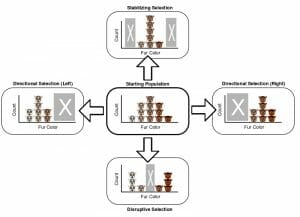Directional selection, stabilizing selection and disruptive selection are three types of natural selection. They are also examples of adaptive evolution. Natural selection is the mechanism of evolution which favors organisms that are better adapted to their environments. Such organisms tend to survive longer and produce more offspring. Selection pressures act against organisms that do not have favorable traits and they are removed from the population. As a result, natural selection plays a major role in the creation of new species over time.
Directional Selection
The English naturalist and scientist Charles Darwin was the first to describe directional selection as a form of natural selection in his foundational 1859 work On the Origin of Species by Means of Natural Selection, or the Preservation of Favored Races in the Struggle for Life.
The directional selection theory says that an extreme phenotype (characteristics or traits) is favored over other phenotypes and this causes the allele frequency (how often the variant of a gene shows up in a population) to shift over time in favor of the extreme phenotype. In other words, if a particular trait is favorable, it will be expressed at the most beneficial frequency in the population.
An example of directional selection is giraffe neck lengths. The environment created a selection pressure which favored giraffes with longer necks who could reach more food in the trees. At the same time, there was selection pressure against giraffes with shorter necks. Both long and short necks are extreme phenotypes, but over time, the long neck phenotype dominated due to selection pressure, i.e., this trait in giraffes shifted toward the direction of long necks.
Stabilizing Selection
Stabilizing selection can be thought of as “middle-of-the-road” selection, meaning a non-extreme trait is favored instead of one of the two extreme traits. An example of this is plant height. In a population of plants, those that are short may not get enough sunlight, but those that are tall may be subjected to wind damage. This results in an increase in the number of medium-height plants and a decrease in very tall and very short plants. Because most traits do not change drastically over time, stabilizing selection is considered to be the most common mechanism for natural selection.
Other examples of stabilizing selection are the birth weight of humans and the number of eggs a bird lays (clutch size). The birth weight of human babies stays within a certain range because babies that have a very low birth weight have less chance of survival and those with a very high birth weight can cause complications during delivery which threaten the life of the mother and the child. The clutch size of bird species is limited to a certain number of eggs. There must be enough eggs so that the clutch can survive predation and/or disease, but not so large that there are too many chicks for the parent(s) to feed.
Disruptive Selection
This type of natural selection is bimodal and favors both extreme traits in a population. For example, in a population of plants, there are some pollinators that visit the tallest plants, a different species of pollinator visits medium-height plants and a third species of pollinator that prefers the shortest plants. If the pollinator that prefers medium-height plants is removed, natural selection would select against medium-height plants and the overall plant population would move toward having only tall and short plants, the two extreme phenotypes.
A more classic example of disruptive selection is the beak size of finches on the Galapagos Islands that was studied by Darwin. Because the majority of seeds found on some of the islands were either large or small, finches with large and small beaks (no medium-sized beaks) were favored on those islands.
Comparison Chart
| Directional Selection | Stabilizing Selection | Disruptive Selection | |
|---|---|---|---|
| Decreases genetic variance in a population | No | Yes | No |
| Expresses extreme traits | Yes | No | Yes |
| Number of traits favored | 1 | 1 | 2 |
| Most common mechanism of natural selection | No | Yes | No |
| Type of selection mechanism effecting the beak size of Galapagos finches | No | No | Yes |

The image above shows the three patterns of natural selection using an allele that determines fur color.
References
- Directional Selection. (n.d.). In Wikipedia. Retrieved October 11, 2017, from https://en.wikipedia.org/wiki/Directional_selection
- Natural Selection. (n.d.). In Sparknotes. Retrieved October 11, 2017, from http://www.sparknotes.com/biology/evolution/naturalselection/section1.rhtml
